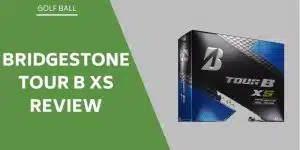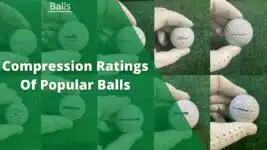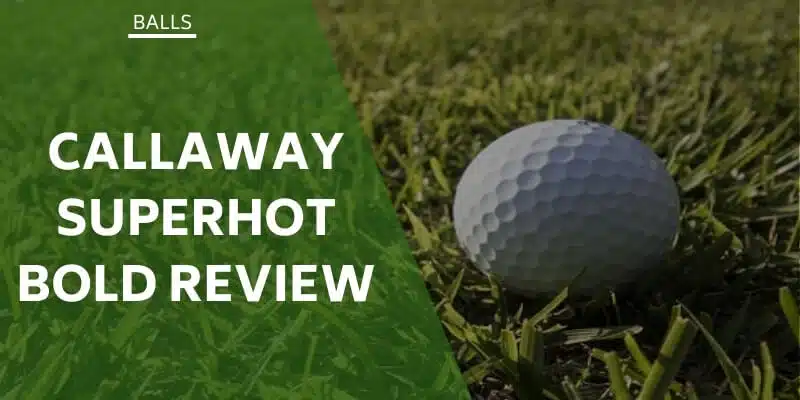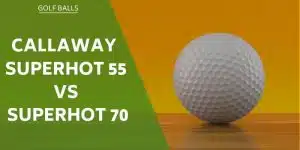Golf is full of questions. When you find the best clubs to buy, courses to play, and shoes to wear, you have to figure out how to pick a golf ball.
If you know your handicap and swing speed, you can answer the question, “which golf ball should I use?”
We have made this as simple as possible so you don’t have to waste any time shopping and can get out there and continue enjoying the greatest game ever played.
Golf ball technology is advanced, but we have handpicked the most essential details and organized them in a way that specifically applies to you and your game. This guide is meant to help you narrow your search so you can decide which ball will help you lower your scores.
What Golf Ball Should I Use? 3 Types To Consider
The type of golf ball you should use is based on your swing speed and handicap. With these two biometrics, we can significantly reduce the number of options you have available.
There are three main factors we consider when matching players to the best golf balls;
- Cover
- Compression
- Number of pieces
A balanced dose of these characteristics will have you shooting the best scores you can and lowering your handicap with ease.
What Is The Best Golf Ball For Me? Quick Quiz
Easily find the right golf ball for you, specifically based on your current stats. I recommend revisiting this golf ball selection guide at the beginning of each season to ensure you are using the most optimal golf ball all the time. Start by answering these questions in this short quiz.
What’s your handicap? (Out of 18 holes) Pick one.
- High Handicapper = 20+
- Mid Handicapper = 10-19
- Low Handicapper = 0-9
What’s your swing speed? Pick one.
- High Swing Speed = 95+ mph
- Low Swing Speed = >95 mph
Based on your handicap and swing speed, you can find which ball is right for you. Check below to find examples of great golf balls to fit your game.
High Handicapper + High Swing Speed
Cover: Hard
Pieces: 3 or 4
Compression: High
Examples: Titleist Pro V1x, Callaway Chrome Soft
High-handicappers are typically in need of two things; consistency and distance. If you’re a high handicapper with a high swing speed, then theoretically, you have an advantage. You need a ball that will work with your inconsistent yet high-speed swing.
Choose something with a harder cover and higher compression. This will help you channel your energy to keep your ball on line more often. You may also experiment with 4-piece golf balls to see if they help add accuracy and shouldn’t lessen your distance much.
The Best Golf Balls for High-Handicappers with High Swing Speed
High Handicapper + Low Swing Speed
Cover: Mid-Soft
Pieces: 2 or 3
Compression: Low
Examples: Taylor Made Noodle Easy Distance, Titleist AVX
It’s much more common for high handicappers to have lower swing speeds. Therefore you have more options when asking, “what golf ball is best for me?”. Adding distance usually tops the priority list, but you want to ensure you will still have good feel around the greens.
Since you will spend a lot of your time on and around the greens throughout a round, don’t get too caught up in looking for the furthest ball. You want distance but from a ball that still has a soft cover. If you go for too much distance, you may struggle on greens that are playing fast.
The Best Golf Balls for High-Handicappers with Low Swing Speed
Mid-Handicapper + High Swing Speed
Cover: Soft
Pieces: 3
Compression: Mid-High
Examples: TaylorMade TP5x, Srixon Z-Star Diamond
As you improve, you require different things from your ball. Hopefully, by this stage in your golfing career, you have harnessed some of that energy you produce with your high swing speed. Now you need a ball that is responsive around the greens to take you to that next level.
Look for a ball that has a softer cover and is a 3-piece. This should add more feel to your game without sacrificing distance. In this case, the compression shouldn’t matter too much as long as it’s above 80.
The Best Golf Balls for Mid-Handicappers with High Swing Speed
Read more: The Best Golf Balls for Average Golfers
Mid Handicapper + Low Swing Speed
Cover: Soft-Med
Pieces: 3 or 4
Compression: Low
Examples: Bridgestone Tour B RXS, Volvik Vimax Soft
Having a low swing speed means you are always looking for that extra bit of distance, but I caution you not to sacrifice your accuracy, which is to thank for shedding your high-handicapper title.
Maintain your accuracy by selecting a 3 or 4-piece golf ball with low compression. This may be tricky to find as most will have a soft cover. This is ok, as it will only help you on the greens. Remember, distance comes from within, so if the core compression matches your swing speed, the cover will not play a huge role until you get to the green.
The Best Golf Balls for Mid-Handicappers with Low Swing Speed
Low Handicapper + High Swing Speed
Cover: Soft
Pieces: 3, 4, or 5
Compression: Mid-High
Examples: Srixon Z-Star, TaylorMade TP5
Low handicapper with a high swing speed is the next most common category, just behind high-handicapper/slow swing speed. There are many options here for you to choose from, and your focus should be on how it affects your spin and feel around the green.
Your cover will be soft no matter what, and you should be using at least a 3-piece golf ball. But be sure your compression is not too high. You may feel the urge to go all out and choose the Pro V1x, but this could cost you distance unless you consistently swing fast, even on your wedges.
The Best Golf Balls for Low Handicappers with High Swing Speed
Low Handicapper + Low Swing Speed
Cover: Mid
Pieces: 2 or 3
Compression: Mid
Examples: Srixon AD333, Wilson Staff Duo Soft
There are more options for you if you find yourself as a low-handicapper with a low swing speed. This happens to all of us as we age, and despite our best efforts, we all sacrifice distance in the long run. But that doesn’t mean we need to sacrifice our scores.
Choose a ball with a lower compression than you normally play. This doesn’t have to be a “low” compression ball, just something less than you’re used to for an added pop on your tee shots. You may even find a two-piece ball that still gives you control over your ball flight while adding a few extra yards to each club in your bag.
The Best Golf Balls for Low Handicappers with Low Swing Speed
Buyer’s Guide To Choosing A Golf Ball
If you want to dig a little deeper into the world of golf balls, be sure to take notes of these aspects. Sometimes it’s hard to find out the information on each golf ball, but I assure you they all rank in all these categories.
Soft Vs. Hard Cover
Determining a soft vs. a hard cover is much more difficult nowadays. Companies are developing more versatile covers that save us from putting too much thought into it.
Many golfers typically prefer soft cover balls despite their skill level. This is for two reasons;
- Soft cover balls offer more control over spin
- Soft cover balls are more accurate
The only golfer that may not benefit from a soft cover ball is someone who swings with a very high swing speed. They may affect too much spin, which will adversely affect the direction of their longer clubs.
Harder balls may also be used based on less-than-perfect course conditions. If the greens and fairways are a little long, then a firm ball will help you get a little extra roll.
What You Should Know About Compression
The compression of a golf ball is the measurement of how easy it is to transfer energy.
- A high compression ball (85+) requires a high swing speed to compress it efficiently
- A low compression ball is softer and makes it easy for golfers with slower swing speeds (>90 mph) to compress it efficiently.
Compression is measured on a scale of 40-110, with the most popular balls falling between 65-90. Below is a list of compressions being offered by some of the most popular golf balls.
| Golf Ball Model | Compression |
| Titleist Pro V1 | 88 |
| Titleist Pro V1x | 98 |
| TaylorMade TP5 | 85 |
| TaylorMade TP5x | 97 |
| Callaway Chrome Soft X | 95 |
| Srixon Q-Star Tour | 72 |
Read head-to-head comparison: Titleist Pro V1 vs Pro V1x Golf Balls
The Number Of Pieces Makes A Difference
Knowing how many pieces make up your golf ball will help you determine how accurate it will be. The most popular are 2 and 3-piece golf balls. There is no such thing as a 1-piece golf ball because, in its most basic form, a golf ball is a core and a cover.
How that core is made and what it’s made from is what separates a range ball from a quality 2-piece option. The price can vary greatly in this category as certain 2-piece balls, such as the Wilson Duo and the Callaway Warbird, are priced less than Titleist Velocity or the TaylorMade RBZ.
The more pieces a golf ball has, the more accurate it will be, but you will sacrifice distance. 2-piece balls will fly further but can be harder to control at higher speeds with your longer clubs. A perfect example is the Pro V1 and Pro V1x. The original version is a 3-piece ball, while the X-version is a 4-piece with higher compression. This means it’s meant for those with higher swing speeds than normal.
For mid-high handicappers, I recommend searching for a 2-piece first and if you really can’t find one you like, then explore the 3-piece balls. But there is no need to move up to the 4 or 5-piece golf balls.
Read more: The Best Srixon Golf Balls
FAQs
Does It Matter What Golf Ball I Use?
Yes, it matters what golf ball you use if you want to improve your game by lowering your score. If your mission is to simply have fun, then by all means, find a cheap golf ball and enjoy your time out there. Selecting your ball will have an effect on your ball flight and spin rate, so if you want more control, then it matters which golf ball you use.
How Do I Know What Golf Ball Is Best For My Swing?
To know what golf ball is best for your swing, you must know your handicap and your swing speed. From there, we can help you narrow your search to just a few golf ball options. The only accurate way to know if a ball is right for you is to put it in play. After a few rounds of use, you’ll see whether it’s a match for your game or not.
How Do I Know Which Golf Ball To Use?
After experimenting and testing a few of them out, you will know which golf ball to use. The right choice is the golf ball that stops quickly on the green, provides optimal launch angle, and gives you close to your maximum distance off the tee.
Does Water Hurt A Golf Ball?
No, water does not hurt a golf ball. It’s perfectly fine to use a ball that has been submerged in the water for any amount of time. Provided it’s not cut, the ball will perform as advertised. If the ball is cut, then it might be compromised. Water leaching in will be absorbed and throw off the weighting, thus affecting all aspects of your ball flight.
Should I Buy Lake Balls?
Yes, you should buy lake balls if you plan on hitting balls in the lake or any body of water. Lake balls are specially designed to be biodegradable, so they won’t harm the ecosystem if left unrecovered. Lake balls are made to feel and perform similarly to traditional golf balls but are much different and should not be used on the golf course.
Summary
Don’t be afraid to experiment. To accurately answer, “what golf ball should I use” you may have to try a few different brands. In most cases, you won’t find the perfect combination of cover, compression, and pieces. Focus on what you feel are your top two characteristics and focus on those.
Above all, remember that nothing about golf is perfect, and sometimes it pays to just go via your gut instinct. Once you’ve scientifically married your search, use your natural instincts to make a final decision. That should result in seeing lower scores in a short time frame.
Read more:
Clint is PGA-certified and was a Head Teaching Professional at one of Toronto's busiest golf academies. He was also featured on Canada's National Golf TV program, "Score Golf Canada," twice. He graduated with a degree in Golf Management from the College of the Desert in California and studied under Callaway's co-founder, Tony Manzoni.
He has a handicap index of 6.2 and spends the winters near Oaxaca, Mexico, where he plays twice a month at the Club de Golf Vista Hermosa. He's written over 100 articles at GolfSpan since 2021. You can connect with Clint at LinkedIn, FB, his website, or Clintcpga@gmail.com.
- Best score: 68
- Favorite club: Odyssey White Hot Two-Ball Center-Shafted Putter
- Favorite ball: Titleist Pro V1x
- Favorite food at the turn: Hot dog



















